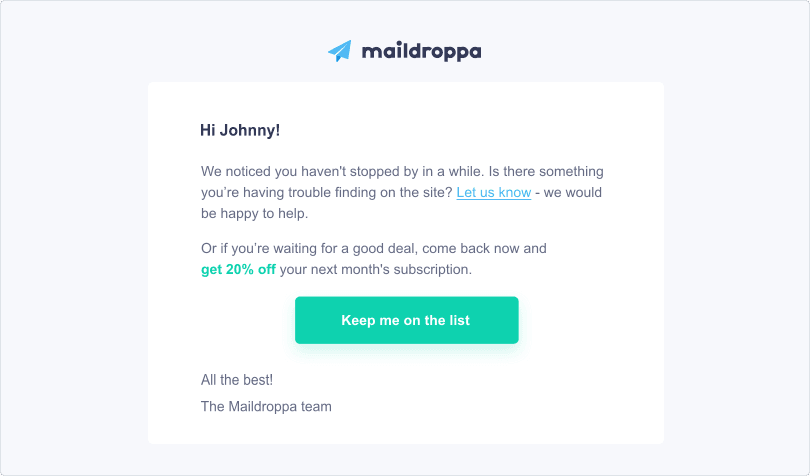Contents
the email tool that makes email marketing simple
Manage Mail Lists: Email List Management Best Practices
Published: May 20, 2024
This guide covers the basics of mail list management, from laying a solid foundation to implementing advanced techniques that keep your subscribers engaged. We explore management best practices and tools for maintaining a healthy email list, email marketing strategies for growth, tips for segmentation and personalization, and how to stay compliant with regulations when you manage mail lists.
We'll also discuss the use of email marketing automation tools, measuring success when it comes to email list management and some advanced techniques that you can use. Our goal is to equip you with the knowledge and tools you need to optimize your mailing lists and ensure your emails reach the right audience. By the end of this guide, you'll know exactly how to improve your email marketing through effective list management.
What Is Email List Management?
Email list management is an important part of successful email marketing. It focuses on how you organize and optimize your contacts to improve your campaign's engagement and effectiveness. It's not just about collecting email addresses! From the moment someone subscribes, every interaction is a chance to better understand and help your audience.
Good email list management allows for precise audience segmentation and message customization, ensuring that the right content gets to the right people. This makes your list more useful and enhances your email marketing's overall value.
Email list management best practices help ensure that your marketing messages are received and acted upon, leading to higher open rates and engagement.
Email segmentation and personalization are the first practical ways you can do this. Let's take a look.
Manage Your Email List Segmentation and Personalization
Segmentation and personalization help to improve the overall success of your email marketing efforts while also making your list easier to understand and manage.
Managing your list segmentation
Segmentation involves dividing your mailing list into smaller, more focused groups based on certain criteria. Understanding your audience's demographics, including age, location, gender, and job title, helps determine the kind of content different segments might find appealing. Looking at behaviors such as purchase history, website activity, email service provider choice, and how they interact with emails gives insights into what subscribers are interested in. This helps you to easily segment your email.
Additionally, knowing who is highly engaged versus those with low engagement allows for adjusting communication strategies to either re-engage or further engage different segments. This division in your list lets you customize your messages to fit the unique needs and interests of each segment, leading to more effective marketing.
Personalization
Personalization takes segmentation further by tailoring emails to each recipient, ensuring the message feels special. This includes using names, referencing past interactions, suggesting products based on purchase history, or sharing content that matches the recipient’s interests. The goal of all of these techniques is to make every subscriber feel valued, increasing the likelihood that they will engage with your emails.
The benefits of these approaches rather than just using email templates are clear. They lead to higher open and click-through rates, build customer loyalty, and improve conversion rates. By delivering content that's not just another email, you create stronger connections with your audience, turning occasional subscribers into loyal customers.
Effective segmentation and personalization also help to reduce unsubscribe rates and spam complaints. When subscribers receive content that’s relevant and useful, they’re more likely to stay interested and less likely to leave. This relevance helps you to stand out when users are flooded with information and offers.
Implementing these strategies requires a good understanding of your subscribers. Tools for data analysis and email marketing software offer insights into their behavior and preferences, guiding your segmentation and personalization efforts. Investing time in understanding your audience leads to a healthier and more effective mailing list.
However, even with proper segmentation and personalization, some subscribers are simply no longer responsive. This means that it's time to clean up your list.
Keeping Your Email List Clean
A good email list is not just about numbers; it's about having active and interested subscribers. Regularly checking your list for inactive subscribers, invalid email addresses, and duplicates is a major part of this.
Contact list re-engagement techniques
It's a good idea to look at re-engagement techniques for subscribers who have become less active over time. One effective strategy is to send a series of re-engagement emails that remind email contacts why they signed up, offering them value that reignites their interest.
Polls or surveys can also be used to re-engage customers and gather feedback that can help improve future email management. Lastly, a simple, direct approach asking if they wish to remain on your list can help clean your list of uninterested parties, keeping your efforts focused on engaged subscribers.
Removing unresponsive subscribers
Once you've identified inactive or unengaged subscribers, they need to be removed. While making your list shorter is never fun, when it comes to a healthy list, sometimes less is more. Tools that automate list cleaning by doing things like removing invalid email addresses, simplify this process. This ensures that your focus can stay on providing good content and expanding your list.
It also helps to make it quick and easy to unsubscribe from email lists. A simple, one-click "unsubscribe" option complies with email marketing regulations and respects recipient preferences, making a user much more likely to consider re-subscribing to your list at a later stage. Your unsubscribe options should be segmented just like your email list is. Most people don't unsubscribe because they don't want any emails at all, they unsubscribe because they're getting too many emails. The easiest way to be sure that you're striking the right balance is often just to let subscribers decide for themselves.
Doing all of this helps to keep your list clean but it also reduces its size. So, you're probably wondering how can you make sure that your mail list grows while you're keeping it clean.
How Do You Grow Your Email List?
Growth strategies, such as incentivizing referrals and optimizing sign-up processes, are an important part of list building. A simple, attractive sign-up form attracts new subscribers. If you place this on a popular part of your website like the homepage or your blog, it can help to maximize signups.
Offering something of value in exchange for an email address, known as a lead magnet, can significantly boost your list numbers. This could be an exclusive eBook, a discount code, or access to a webinar, tailored to your audience’s interests and needs.
Using social media and partnerships for growth
Social media platforms present more fertile ground for list growth. Regularly promoting your newsletter or sharing snippets of the high-quality content subscribers can expect will attract followers to sign up. Additionally, consider using social media advertising targeted at your ideal audience demographic to drive signups. Interactive content, such as quizzes or polls with a follow-up email result, also encourages users to subscribe.
Collaborations and partnerships with complementary businesses or influencers can exponentially increase your reach. Co-hosting events, webinars, or creating joint content allows access to one another’s audiences, presenting a natural opportunity for audience members to subscribe to your list if they find value in the shared content.
Keep your list growth healthy with enhanced sign-ups
If you attend industry events and conferences or have a physical storefront, it's a good idea to use these to grow your contact list. Offering a quick and easy way for people to sign up, perhaps through a QR code that leads directly to a signup page, can tap into the potential of in-person interactions. Remember, the key is to make the process as seamless as possible, minimizing barriers to subscription. It's also important to make sure that everybody who signs up actually wants to.
This is why optimizing the signup process itself is critical. Using double opt-in means subscribers first sign up and then confirm their subscription via email. This will help to keep your list quality high while it grows, letting you save time on list hygiene later on. A/B testing different elements of your signup forms, from the call-to-action text to the design and placement, can reveal what works best for converting visitors to subscribers. Ensuring that your website is mobile-friendly is also important, as a significant portion of users will interact with your content on mobile devices.
Finally, improving email quality itself is crucial for list growth. Word-of-mouth recommendations from current subscribers can be a powerful tool for organic growth. If your content consistently delivers value, your subscribers will become your most effective advocates, sharing your sign-up links with their networks and growing your list without you having to do any work.
Leveraging Email Marketing Automation for Email Management
Email marketing automation offers a seamless way to enhance the efficiency and effectiveness of your campaigns. By automating repetitive tasks with a management tool, you'll be free to focus on strategy and creative content for different emails, while the software handles the finer details.
Email management software can automatically segment subscribers based on their behavior or demographics, send emails in bulk, and even manage unsubscribe requests and list cleaning. This level of automation ensures that your list remains dynamic, engaged, and clean, without requiring constant manual oversight.
Moreover, email marketing automation can schedule and send emails at the optimal time for each segment, increasing the likelihood of engagement. Welcome email sequences, re-engagement campaigns, and targeted promotional messages can all be automated, ensuring that subscribers receive relevant content at each stage of their journey.
The strategic use of automation tools streamlines list management and elevates the subscriber experience. By delivering timely and personalized top email content, you deepen the relationship with your audience, fostering loyalty and driving conversions.
As we move forward, understanding how to measure the success of your email list management becomes crucial. The next section will delve into the metrics and insights that can help you gauge the health of your list, the effectiveness of your engagement strategies, and the overall impact of your email marketing efforts.
Measuring Success in Email List Management
When managing email lists, it's important to measure the effectiveness of your strategies to understand what drives success. Measuring success goes beyond simply tracking list growth; it also includes analyzing engagement, conversion rates, and the overall health of your email list. Below are some of the key metrics that you can use to manage your email list.
Open rate
This is the percentage of email subscribers who open your emails. It provides insight into how engaging your subject lines are and how relevant your content is to your target audience. If you're underperforming in this area, it's probably time to revise, segment, and personalize your list.
Click-through rate (CTR)
This is the ratio of subscribers who click on the links in your email to the total number of emails opened. The CTR is a direct indicator of how engaging and activity-oriented your email content is. If your CTR is poor, it can often mean that your subscribers aren't particularly interested in your content.
Conversion rate
This measures the percentage of email recipients who have completed a desired action, such as making a purchase or signing up for a webinar. It's a good indication of how relevant your content is to the subscribers on your list.
Bounce rate
This is the rate at which your emails do not arrive in the recipient's inbox. A high bounce rate can indicate problems with email deliverability or list quality. If your bounce rates are high, it's time to clean out your list.
List growth rate
While the length of your list isn't the only measure of success, healthy growth means continued interest in your brand. The rate at which your list is expanding is a direct measure of how effective your growth strategies are.
Unsubscribe rate
The unsubscribe rate is how often people are unsubscribing from your mailing list. While it's normal for some subscribers to leave is normal, a high unsubscribe rate could be a sign that the content or the frequency isn't right.
Monitoring these metrics will give you a good idea of your email list's overall health as well as which areas need more focus. In addition, there are some more advanced techniques which can help you manage your email list.
Advanced List Management Best Practices
Adopting advanced email list management techniques can significantly boost the effectiveness of your email campaigns. Here are some cutting-edge strategies:
- Predictive Analytics for Better Segmentation: Use tools like Google Analytics to analyze subscriber behavior, enabling refined list segmentation based on predicted behaviors.
- AI-Driven Personalization: AI technologies offer hyper-personalized email content by analyzing data on an individual subscriber's interactions and preferences.
- Automated Re-engagement: Set up automation for re-engaging dormant subscribers with personalized emails. This will keep your list active and clean.
- Interactive Emails: Enhance engagement by adding interactive elements like polls and surveys to collect valuable feedback within emails.
- Cross-Channel Integration: Connect your email campaigns with other marketing channels for a unified strategy, enriching subscriber data across platforms.
With these advanced strategies, it's possible to significantly refine your approach to email list management.
Remember to navigate the legal and compliance aspects carefully to ensure your practices are effective and compliant. We'll expand on this in the following section.
Legal and Compliance Considerations in Email List Management
Navigating the legal and compliance landscape is a critical component of effective email list management. Adhering to regulations protects your business from potential fines and builds trust with your subscribers, enhancing the overall health of your contact list. Ensuring you have explicit consent from individuals before adding them to your email list is crucial. The use of double opt-in methods keeps your list clean. It's a best practice that provides clear evidence of consent and significantly reduces the risk of spam complaints. This is why it's part of the General Data Protection Regulation (GDPR).
Compliance with data protection laws such as the GDPR in the EU and similar regulations worldwide is essential. For your mailing list, this means all of the subscribers' email addresses. These laws require the transparent handling of personal data throughout your email marketing campaign, including its collection, storage, and usage. Ensuring subscribers can easily access your privacy policy and understand their rights regarding their data is a key part of this compliance.
Every email must include a straightforward and easy-to-use mechanism for unsubscribing from your mailing list. This ensures compliance with laws like the CAN-SPAM Act in the United States. You must also ensure that your email content is truthful and not misleading. This includes having accurate "From," "To," and "Reply-To" information, as well as clear subject lines that reflect the email's content.
Maintaining records of consent and all communications with subscribers on your list is vital in demonstrating compliance with email marketing laws and regulations. By prioritizing these legal and compliance considerations, you safeguard your email marketing efforts against legal challenges and build a foundation of trust with your subscribers. This strategy mitigates risks and reinforces the integrity of your email list management practices.
Next, we'll look at Maildroppa, an email marketing tool designed for effective list management, offering features that ensure compliance and enhance your email marketing efforts.
Introducing Maildroppa: The Best Email List Management Software
Email list management can be daunting and complicated, especially for startups, bootstrappers, solo founders, and indie hackers. Ensuring compliance, targeting subscribers effectively and maintaining the health of your contact list is a huge challenge. However, Maildroppa is an email marketing platform that makes this faster and easier.
Why choose Maildroppa to manage email lists?
Maildroppa is an email marketing service designed to address common challenges in email list management as well as general email marketing campaigns. Its features aim to streamline list management, enhance subscriber engagement, and ensure compliance with legal standards. The platform offers a wide range of functionalities, including drip campaigns, welcome series, advanced segmentation, and personalized content, providing all the necessary tools for effective email list management.
Maildroppa offers a straightforward approach to email list management, blending email automation with personalization, and ensuring that you're always compliant. With our comprehensive toolset, you can improve your email marketing efforts and watch your email strategies evolve into meaningful interactions with your target audience.
The best part is that it's completely free for your first 100 subscribers, with all advanced email features and unlimited emails available.
In conclusion, Maildroppa stands out as an optimal choice for managing email lists, offering a seamless blend of automation, personalization, and compliance features to enhance your email marketing strategies at no cost for the first 100 subscribers.




